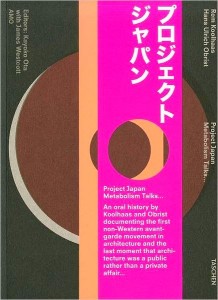JQ Magazine: Book Review – ‘Project Japan: Metabolism Talks’

"What’s most striking about 'Project Japan' is the text itself, a frenetic landscape of drawings, photographs and textual tidbits both fluid and choppy. The book is also a portrait of a moment; once futuristic, now historical, yet still as influential as ever." (Taschen America)
By Sharona Moskowitz (Fukuoka-ken, 2000-01) for JQ magazine. Sharona is interested in fresh, new voices in fiction and creative nonfiction.
What does it mean to be a Japanese architect, and is this distinction even worth making? According to Rem Koolhaas, the legendary architect and co-author of the book Project Japan: Metabolism Talks, the answer is unequivocally yes. As he puts it, “The Japanese are a group of modernists that never entirely cut connections with the past. That is probably still something one intuitively senses when they look at Japanese architecture.”
Project Japan (co-written with Hans Ulrich Obrist) offers a documentary-style look at the avant-garde Metabolism movement that flourished in Japan after World War II. While the country was recovering from the war and reinventing its image, the Metabolists strived to make architecture “a public rather than a private affair,” designing for a widescale shift from the rural to the urban.
What’s most striking about Project Japan is the text itself, a frenetic landscape of drawings, photographs and textual tidbits both fluid and choppy. It’s essentially a reference book, reading like a series of presentations whose format begs audience interaction. The book offers an intimate glimpse into the lives of the men responsible for propelling the movement forward and the processes involved. The book is also a portrait of a moment; once futuristic, now historical, yet still as influential as ever.
When I arrived in Tokyo in 2006 for my second stint of living in Japan, I decided on a whim to visit starchitect Kisho Kurokawa’s Nakagin Capsule Tower for a quick look. I was a casual spectator with only a basic Wikipedia-like understanding of his buildings, though I knew the tower was the capstone of his work. Looking at the unusual edifice with its washing machine-like stacked compartments and bug-eyed windows, I didn’t realize at the time that it was the seminal landmark of an entire movement. I also had no idea that I was caught in something of a time warp, observing a once futuristic building that was now a relic and could soon be a ghost. (Now in disrepair, the fate of the tower is still up in the air.)
Like other Metabolist works, the Nakagin Capsule Tower was built to adapt, with a modular design that could be reworked and adjusted to the needs of its inhabitants. Many of the Metabolist buildings and public spaces are a clear reminder that architecture does and should have an applied use; it should pay attention to how people behave both individually and en masse and it should be able to adapt to the times, keeping a sharp eye toward the future. Metabolist architecture is meant to be flexible, “metabolizing” within the living organism of the city.
The dynamic spirit of the Metabolist movement charges through the dense pages of Project Japan with a jolt. It’s easy to see how the Metabolists paved the path for future Japanese architects who would come to be appreciated the world over as arbiters of the weird, cool and futuristic.
For more on Project Japan, click here.


Comments are closed.